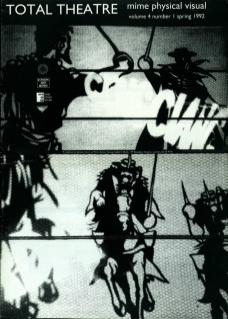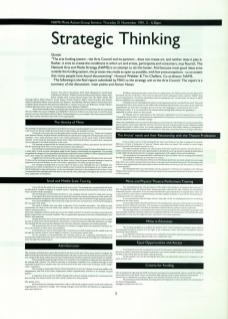Present: Tina Glover (Facilitator), Ruth Glick (Rapporteur), Geoff Beale (Ophaboom Theatre), William Dashwood/Rosemary Harvey (Smart Arts), Karen Gartzke (Arts Council Drama Dept), Peta Lily (Mime Artist), Mel Jennings (Black Mime Theatre), Penny Mayes (Trestle Theatre), Helen Carter (London Arts Board), Anthony Bracnum / Martin Grant (Inside Out Theatre), Sue Mitchell, Maureen Salmon (South East Arts / CORAA), Shani Solomons, Nick Ewbank (Old Bull AC), Helen Lawrence, Jac Wilkinson, Freida O'Byrne, Graham Marchant (Arts Council Touring Report), Katie Williams (NAMSU).
Tina Glover introduced the meeting by indicating that the seminar would in the main be examining the two NAMS documents ‘Drama’ and ‘Training’. However, if there were items not covered by these reports, and she cited Naseem Khan's Mime Training Report as one example, then those present should raise those points whenever they felt it to be appropriate
The Identity of Mime
The meeting was pleased to note that for once Mime was not just a small paragraph in an Arts Council document. It felt, however, that the NAMS documents did not fully address the problems of mime.
It was felt to be ironic that at a time when Mime's profile was on the way up – Theatre de Complicite at the National Theatre, Stephen Berkoff and Richard Jones’ productions using mime techniques, plus many more examples – most mime performers felt it to be counter productive to use the word ‘mime’ in their publicity material. On the whole the meeting felt that the terms ‘Mime’ and ‘Physical Theatre’ as used in these documents was an adequate if not ideal description of the work.
The meeting recognised that the identity problem extended to audience perceptions but did not feel that the marketing needs had yet been properly analysed and addressed
The meeting recommended that the Arts Council consider restructuring its Drama department to cover a wider brief. A more accurate description might be the Theatre of Performing Arts department. The meeting recognised the dangers of very generalised departments and felt the needs of theatre could be safeguarded under such a new system by retaining Officers with specific artform responsibilities.
A significant concern was the need to continue to develop the representation for mime in the arts world. To that end the meeting recommended that the Mime Action Group be given increased funding to ensure its long-term security and facilitate its role as the lobby organisation for mime and physical theatre.
The meeting concluded that it was the nature of mime to tour. Although the use of buildings was important (see ‘Artists' Needs’ below), it was not useful to look towards the development of one Theatre space wholly dedicated to mime performance, as this was ultimately restrictive to development of the artform. It was recommended that building-based work that was site-specific and could happen throughout the country was the more appropriate development.
Small and Middle Scale Touring
It was felt that the small-scale touring circuit was in crisis. The meeting also recommended that funds be allocated as a matter of urgency to support venues, marketing, technical and personnel resources as they were currently wholly inadequate.
The meeting also recommended that there be one complete network created for small-scale touring.
It was agreed that mime was often more artistically suited to the intimate playing areas of the small-scale and the meeting took exception to the idea that growth to the middle-scale was somehow a sign of greater quality.
The current debilitation of the small-scale might prevent new and innovative work from developing as this was their entry point.
The push to middle-scale was often a reflection of the economic necessities – the ability to raise sponsorship was cited as one such necessity. Middle-scale venues also provided the much needed support systems mentioned above. If artists and companies wanted to make the move to the middle-scale then it would be necessary to provide much greater support than was currently available. This was particularly important in the areas of administration (see below), and marketing.
Despite the points above it was also felt that mime should not always be pigeon-holed as small- or middle-scale but that an ideal future should include the opportunity to present productions with fifty performers on stage. The meeting felt that much greater dialogue was necessary between companies and venues generally.
The proposal that one or more companies be funded at a higher level was cautiously welcomed, but not at the expense of other artists and companies.
It was felt that one way in which small-scale companies successfully transferred to the middle-scale was through site-specific projects, which might be residency- or performance-based work.
On the question of Internationalism the meeting endorsed the continuing development of an international profile but felt that more note should be taken of the large amount of touring now undertaken by mime through The British Council.
Administration
The meeting concluded that a great deal needed to be done in this area. There was a need to recognise the different training needs inherent in administering small-scale mime work. In the main this was because the work was created in the studio rather than text-based. Administrators therefore required a much broader set of skills.
The meeting discussed the high incidence of cooperative run companies in mime and how this affected the training skills required. The different structure of cooperative companies was considered, though no firm conclusion was reached as to whether they were such because of the style of the work or because of the youth of the companies.
The meeting recommended that the Drama department review the training of small and middle scale administrators and look at the Dance department's trainee apprenticeship schemes as an example of good practice.
A rapporteur from a previous NAMS meeting held to discuss training, analysed the conclusions from that meeting (see below), which were then wholly endorsed by those present. The points were:
A) Investment in training is essential in order to effectively support creative work and enable arts organisations to respond to change. The training strategies must therefore be linked to an organisation’s aims and objectives.
B) Where training takes place away from an organisation, the skills learned must be allowed to feed back into the work place. Time must be allowed to brief colleagues. There could be ‘INSET’ days for arts organisations – the whole organisation takes a training day out, or takes time in retreat to allow time to assimilate new information.
Human resource management exists in small organisations but is not labelled as such. The work demands that this is done whatever the skills of the individual administrator concerned. Some small arts organisations are innovative managers but do not have the language to communicate this to arts training providers. It is recommended that independent training skills advisers be appointed regionally to advise clients on their needs.
D) Change must be appropriate to the particular organisation and not imposed from outside. Training has to be sensitive to the position the organisation is currently in, the direction in which it is moving, and the speed at which it can assimilate change. There was considerable concern expressed about the poor level of pay for administrates in mime and that there was no viable career path within the artform. This led to the loss of people and also difficulty funding appropriate people to replace them. As a result companies often had to offer higher salaries to administrators. Where companies were run cooperatively this could lead to artificially created hierarchies, resulting in difficulties.
The Artists' needs and their Relationship with the Theatre Profession
It was a major concern of the meeting that the Arts Council had not yet fully recognised the intrinsic difference of mime, it being part of process theatre rather than text-based. This resulted in much longer rehearsal periods and therefore increased costs.
The artists need better facilities, not only because of the time required to rehearse, but also because a better environment would create more opportunities to develop the work – e.g. properly equipped studio spaces would enable the physical performer to prepare appropriately with regular classes and workshops.
The meeting also recommended that consideration be given to artists’ need to recharge their batteries through the funding of sabbaticals and bursaries for courses.
It was felt that Cross-fertilisation with the rest of the theatre profession was rarely carried out on an equal basis. There was a need to educate Directors in how to use mime and movement-based work. The meeting would welcome more opportunities for mime artists to direct and therefore not always be the movement coordinator or choreographer.
The meeting felt that it was interesting to cite the appearance of Theatre de Complicite at the National Theatre in the context of cross-fertilisation; the irony that the work in question had been text-based was not lost on those present.
Mime and Physical Theatre Performers Training
The meeting felt that the only document to fully address the problems of training in this area was ‘A Way Through the Mimefield’ by Naseem Khan. Numerous points, which for the sake of brevity are not detailed here, echoed the report's conclusions. It was recommended that the report should now be implemented. There was a note of dissent on the subject of initial training currently available in Britain. It was felt that Desmond Jones’ contribution had been undervalued.
It was recommended that the Mime Action Group uptake on the coordinating function for workshops identified in the Khan report.
It was recognised that a fundamental barrier to developing mime education and training was the absence of mime from the National Curriculum. The meeting recommended that NAMS should address the problem of arts provision in the National Curriculum as education created at the levels of the audience and the performer.
The meeting further recommended that courses to learn to teach in the community (e.g. people with special needs) would be extremely useful. It was established that the Arts Council does currently provide some opportunities in this area that might be better advertised to the mime profession.
Mime in Education
The meeting identified as a problem the limited extent of the funding for animateur posts which it recommended should be looked at in the light of the Community Dance and Mime Foundation's Review document when published.
It was felt that it should be noted that some companies were suited to present work and others to work within the community – different skills were required for each.
Equal Opportunities and Access
It was pointed out to the meeting that much of the discussion, particularly in the area of training, had been Euro-centric. It was felt to be equally true that there were some examples of good practice in the companies, but that on the whole they do not reflect cultural diversity
On the question of access the meeting felt that mime was particularly advanced in comparison to the other artform areas.
Criteria for Funding
The meeting felt strongly that the NAMS Assessment document was impenetrable and as a result felt unable to discuss this item in any detail. There was therefore little criticism of the current methods of assessment. It seemed that a combination of audience figures and informed comment was the current means.
The meeting recommended that nurturing artistic developments in mime should be the cornerstone of any future funding policy.

